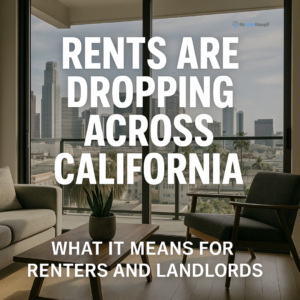California’s rental market is showing some meaningful signs of softening and that’s a noteworthy shift for tenants, landlords, and property managers alike. A recent article by the Press-Telegram reports that 8 of the 15 major California metro rental markets they surveyed saw year-over-year asking rent declines in 2024.
A Snapshot of the Data
While the article doesn’t publish the full breakdown of all 15 metros, the headline figure is compelling: more than half of the regions studied experienced rent reductions. These declines suggest a moderation in rental growth and possibly a rebalancing after the sharp increases seen during and post the pandemic.
Why Are Rents Falling?
Several converging factors help explain the trend:
-
Supply catching up to demand: In markets where new development has been coming online and vacancy has edged up, landlords may have less pricing leverage leading to softer asking rents.
-
Flattening or declining demand: With migration patterns shifting, work-from-home arrangements stabilizing and fewer dramatic population inflows, some markets face less upward pressure on rents.
-
Post-pandemic correction: Some markets saw steep rent hikes during the pandemic and its aftermath; a correction or pull-back naturally follows when the starting point becomes high.
-
Affordability constraints: Renters and households facing high costs may push back or look elsewhere, creating more competition among landlords and listing agents to fill units.
Markets Where Rents Fell the Most
While the article provides a statewide overview, supplementary data suggests specific metros in California with significant relative declines. For example:
-
The metro area of Riverside–San Bernardino–Ontario, CA (an inland Southern California market) reportedly saw rents fall by about 4.8% year-over-year in a recent study.
-
The San Diego–Chula Vista–Carlsbad, CA metro area also registered a decline of approximately 4.9%.
These examples suggest that inland or once-high-growth ex-urban markets may be feeling the softening more acutely than the most expensive coastal markets.
Implications for Renters
For individuals renting or looking to rent, these developments can offer some advantages:
-
Greater negotiation leverage: In markets where asking rents are declining, tenants may have more room to negotiate renewal terms, move-in concessions, or more favorable lease terms.
-
More choices: Softer conditions may lead to more available units, added amenities or incentives, and more time to compare.
-
Opportunity to lock in rates: If rents are trending downward or stabilizing, renters may choose to secure favorable terms now before any uptick in the future.
Implications for Landlords & Property Managers
For property owners and professionals such as you in your role with McIntire Kingstone this trend invites strategic review:
-
Re-evaluate pricing strategy: If rent reductions are occurring, asking rates should be aligned with local market conditions to avoid extended vacancies or having to offer larger concessions.
-
Enhance value proposition: With more competition, units that stand out (better condition, attractive amenities, responsive management) will perform better.
-
Focus on retention: Keeping solid tenants may become more important; turnover = downtime and cost.
-
Control operating expenses: Lower rents or slower growth may squeeze margins, so vigilant cost control vendor management, maintenance efficiency, utility oversight becomes more critical.
-
Local market differentiation: Coastal premium markets might still show strength; inland/secondary markets may require different tactics (e.g., targeted upgrades, marketing focus, unit size mix) to maintain occupancy and returns.
What It Means for Your Property Management Checklist
Since you work on SOPs, checklists, and workflows for your property management company, here are a few ways to integrate this market insight:
-
Weekly/Monthly Leasing Review: Add a step to review and compare actual asking rents versus comparable market rents in your metro area flag any asking rents that are above current market trends.
-
Turnover Process Add-on: Include a “Pricing Check” at the unit-ready stage: verify the recommended rent aligns with current market data, adjust for time-on-market and concessions if the trend is downward.
-
Vendor & Cost Review: As part of monthly maintenance and operations, check whether vendor contract pricing and unit turnover costs are still optimized in a softer rent market, cost containment is more important.
-
Annual Budgeting: For CAM reconciliation, budgeting, and lease renewals (especially in your commercial and multifamily segments), assume more conservative rent growth (or flat/negative growth) so you build in contingency.
-
Marketing Strategy Update: If you are overseeing marketing workflows, ensure asset listings communicate value clearly e.g., “amenities included”, “flexible lease terms”, “recent renovations” rather than relying solely on pricing strength to drive demand.
Looking Ahead: Will the Trend Continue?
Several macro-factors will influence whether these rent declines remain temporary or develop into a longer-term shift:
-
Interest rates and cost of capital: Higher rates may cool investor appetite and slow new supply, which might support rents later.
-
New construction and supply pipeline: If many units are delivered in a market, the extra supply could sustain downward pressure on rents.
-
Employment & migration patterns: Regions that attract jobs and population will rebound faster; regions with out-migration may face longer headwinds.
-
Regulation and policy: Changes in zoning, rent control, tax incentives, and housing policy can alter supply/demand balance regionally.
-
Local economic health: Industries driving demand (tech, education, healthcare) and regional economy resilience matter a lot for rental markets.
Final Thoughts
This rent-softening signals a shift in what for many years was a relentlessly upward trend in California’s rental market. For renters it’s a potential window of relief; for property managers and owners it’s a moment to sharpen strategy and stay ahead of changing market dynamics.
Since you’re actively building checklists, SOPs and workflows within your property-management operations, integrating the notion of “adaptive pricing and cost control in a softening rent market” may add real forward-looking value.
Source: https://www.presstelegram.com/2025/01/08/where-did-california-rents-fall-the-most-last-year/

